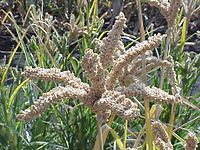
Photo from wikipedia
Pearl millet is one of the most important small-grained C4 Panicoid crops with a large genome size (∼2352 Mb), short life cycle and outbreeding nature. It is highly resilient to… Click to show full abstract
Pearl millet is one of the most important small-grained C4 Panicoid crops with a large genome size (∼2352 Mb), short life cycle and outbreeding nature. It is highly resilient to areas with scanty rain and high temperature. Pearl millet is a nutritionally superior staple crop for people inhabiting hot, drought-prone arid and semi-arid regions of South Asia and Africa where it is widely grown and used for food, hay, silage, bird feed, building material, and fuel. Having excellent nutrient composition and exceptional buffering capacity against variable climatic conditions and pathogen attack makes pearl millet a wonderful model crop for stress tolerance studies. Pearl millet germplasm show a large range of genotypic and phenotypic variations including tolerance to abiotic and biotic stresses. Conventional breeding for enhancing abiotic and biotic stress resistance in pearl millet have met with considerable success, however, in last few years various novel approaches including functional genomics and molecular breeding have been attempted in this crop for augmenting yield under adverse environmental conditions, and there is still a lot of scope for further improvement using genomic tools. Discovery and use of various DNA-based markers such as EST-SSRs, DArT, CISP, and SSCP-SNP in pearl millet not only help in determining population structure and genetic diversity but also prove to be important for developing strategies for crop improvement at a faster rate and greater precision. Molecular marker-based genetic linkage maps and identification of genomic regions determining yield under abiotic stresses particularly terminal drought have paved way for marker-assisted selection and breeding of pearl millet cultivars. Reference collections and marker-assisted backcrossing have also been used to improve biotic stress resistance in pearl millet specifically to downy mildew. Whole genome sequencing of pearl millet genome will give new insights for processing of functional genes and assist in crop improvement programs through molecular breeding approaches. This review thus summarizes the exploration of pearl millet genetic and genomic resources for improving abiotic and biotic stress resistance and development of cultivars superior in stress tolerance.
Journal Title: Frontiers in Plant Science
Year Published: 2017
Link to full text (if available)
Share on Social Media: Sign Up to like & get
recommendations!